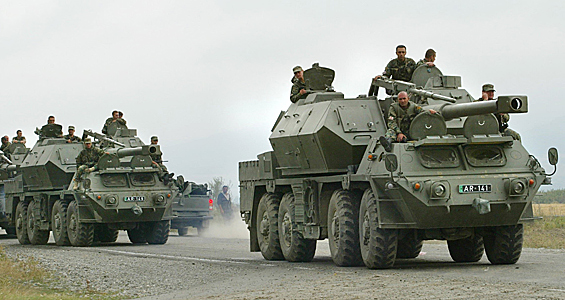Timeline: Georgia and South Ossetia
Key events in Georgia from the country’s independence in 1918.

 |
| South Ossetia broke away from Georgia in the early 1990s and is now supported by Moscow [AFP] |
1918: Georgia declares independence after more than 100 years of Russian rule.
1921: Red Army invades and Georgia becomes a Soviet socialist republic.
1989: About 20 Georgian pro-independence activists killed by Soviet troops in Tbilisi. Georgians and Ossetians clash over demands for greater autonomy for South Ossetia.
1991: Georgian people vote overwhelmingly for independence in a referendum. Georgia leaves Soviet Union. Gamsakhurdia elected president of Georgia.
1992: Fighting breaks out in Tbilisi between government and opposition troops. Gamsakhurdia deposed and Eduard Shevardnadze takes power. Separatist troops in Abkhazia engage Georgian forces.
1993: Georgian troops driven out of Abkhazia after fierce fighting.
1994: Ceasefire signed between Tbilisi and Abkhaz separatists. Russian peacekeepers begin to patrol the disputed region.
2001: Georgia and Abkhazia sign an agreement against the use of force in their dispute, but series of skirmishes later in the year.
2003: Peaceful “Rose Revolution” leads to Shevardnadze’s removal.
2004
January: Mikheil Saakashvili wins presidential elections.
May: Tbilisi refuses to recognise parliamentary elections held by South Ossetia.
August: Series of clashes erupt between Georgian and South Ossetian soldiers.
2005: South Ossetia rejects a Georgian offer of autonomy within Georgia.
2006
January: Saakashvili accepts gas from Iran after blaming Moscow for an explosion that damages a main pipeline delivering Russian gas to Georgia.
February: Georgian parliament votes unanimously for international peacekeepers to replace Russian forces in South Ossetia.
November: South Ossetia holds referendum intended to reaffirm independence from Georgia. The West calls the vote illegal, but Russia says it should be respected.
2008
January: Mikheil Saakashvili re-elected.
July: Heightened tension between Georgia and Russia, with several explosions in Abkhazia. US warns Russia against stoking tensions in breakaway regions.
August: Heavy fighting breaks out in South Ossetia, killing six people and injuring seven. Georgian tanks launch an attack on Tskhinvali, the capital of South Ossetia, killing at least 15 people.
Russian forces respond by air raids in South Ossetia, and at least 30,000 people flee the fighting. Russian forces take control of Tskhinvali, and Georgia orders its troops in South Ossetia to cease fire. The two sides eventually sign a peace agreement brokered by France.
September 17: Dmitry Medvedev, the Russian president, signs treaties with South Ossetia and Abkhazia, committing Moscow to defend Georgian breakaway regions from “outside attack”.
October 1: European Union observers start patrols in Georgia to observe a ceasefire between Georgian and Russian forces.
October 3: At least six people are killed in a car bomb at the Russian army’s headquarters in Tskhinvali.
October 8: Russian troops complete a pullout from buffer zones next to Georgian regions that it had established during the war.
October 27: Saakashvili names Grigol Mgaloblishvili as prime minister, saying Georgia needs “new energy” to tackle challenges after the country’s war with Russia.
November 18: Thousands of opponents of Saakashvili rally in Tbilisi to demand early elections.
2009
January 28: Georgia captures a Russian soldier in South Ossetia, Russia’s defence ministry says.
January 30: Mgaloblishvili resigns on health grounds.
February: Nika Gilauri becomes prime minister.
April 9: Tens of thousands of opposition supporters launch protests in Tbilisi calling for the president to step down.
April 14: Saakashvili accuses Russia of financing the rallies calling for his resignation.
April 16: Russia demands Nato call off military exercises to be held in Georgia in May, saying they will “complicate” tensions in the region.
May 5: Soldiers from a tank battalion in the Gori region stage a one-day mutiny. Georgia’s interior ministry says Russia behind the rebellion aimed at disrupting Nato exercises. Moscow’s envoy to Nato denies any involvement.